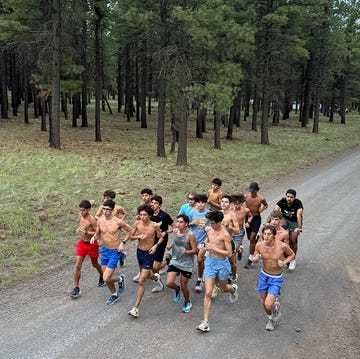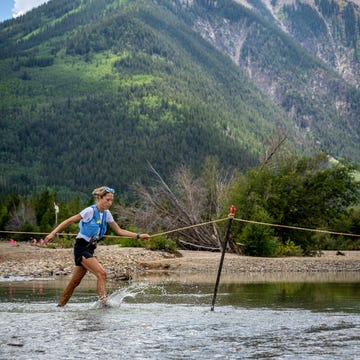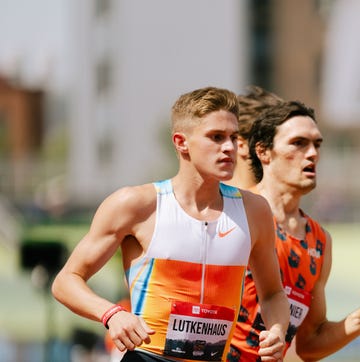Governor Tim Walz is running—and not just for the job of vice president of the United States of America. In July, before Democratic nominee Kamala Harris picked Walz as her partner in the 2024 presidential election, Runner’s World spoke with the Minnesota governor about how running helps him de-stress and provides a sense of community.
It’s been a whirlwind few weeks since Walz joined the ticket, but hitting the campaign trail with Harris hasn’t hindered his running routine. Earlier in August, Walz was spotted running in his beloved Hoka Bondi 8s, the shoes that “changed my life,” as he told RW.
The only thing that has changed is who’s tagging along on Walz’s runs. Because as a candidate for higher office, the governor has been granted a Secret Service detail, which means his current running club is of the heavily armed variety.
When a high-profile political figure is assigned protection, it stands to reason that the Secret Service goes where their protectee goes. So if their assignment wants to get a brisk jog in, well, the Secret Service detail had better lace up their running shoes. In fact, keeping up with a president on the run is something the Secret Service has done for almost 50 years.
President Jimmy Carter was described as “an avid jogger” by the New York Times in a 1979 article, which actually described Carter, exhausted during a 10K race, needing to be helped off of the course by his Secret Service detail. Since then, nearly every president has taken to running as a form of exercise, from George H.W. Bush, who reportedly often invited a reporter from The Dallas Morning News along on his jogs to catch up on Texas gossip, to Barack Obama and Joe Biden, who once filmed a video of themselves jogging around the White House during the former’s administration, tied into Michelle Obama’s “Let’s Move” campaign. During his own presidency, Biden tended to prefer bike riding over running for his exercise of choice, while Presidents Reagan and Trump’s primary exercise appear to be horseback riding and golf, respectively, rather than running.
Of course, for readers of a certain age, the image that comes to mind on the topic of “Presidents running with Secret Service” isn’t actually a president at all. It’s Phil Hartman on Saturday Night Live, in the famous sketch where Bill Clinton diverts his morning jog into a McDonalds detour, while his Secret Service detail tries to get him back to his workout (the sketch, and Clinton’s documented love of the fast-food chain, was even referenced at this year’s DNC).
But you might be surprised to learn that the most serious runner of any modern president was actually George W. Bush. He discovered a love of running all the way back in 1972 and credited it for helping him eventually quit smoking and drinking. By 2002, he was such an advocate for the benefits of running that he took time out of his then-presidential duties to speak to Runner’s World about his exercise habits. “Usually I run 6 days a week,” he told RW back in 2002, “On Sundays, if I’m at Camp David, I’ll go for a hard morning run—these days about 20:30 to 20:45 for 3 miles on a tough course—and then I’ll go walk 2 to 4 miles with Laura [the First Lady] afterward.”
President Bush even had what he called the “100 Degree Club,” which came about when the then-campaigning Bush decided a 100-degree day in August simply needed to be run in. “So as I recall there was a change of shift of the Secret Service agents,” President Bush said, “And I just told them that we should all go for a run right then. So both shifts of agents went right with me in the heat.”
So just how difficult was that 100 degree run for the Secret Service agents at the time? One of them, retired agent Nick Trotta, told Runner’s World about it back in 2012:
“Heat runs were tough. Agents have to wear long shirts to cover our holster, firearm, handcuffs, and radio. We also wore a microphone hooked to our index finger that wouldn’t interfere with grabbing the president or using our weapon.”
Keeping Up Today
So that’s what it was like for a Secret Service agent to run with a candidate in the year 2000. But what is it like today? How could we possibly peer into the inner-workings of the famously stoic and tight-lipped Secret Service to find out who gets to run with the president, how they get picked, and crucially, what their preferred brand of running shoe is?
Well, as it turns out, we could just shoot them an email.
We corresponded with Alexi Worley from the Secret Service’s Office of Communication and Media Relations, who explained that while the details of how specific running routes are chosen and other logistical matters couldn’t be discussed (you know, that whole national security thing), they could give us some insight into the expectations for an agent’s physical fitness and who gets chosen for certain athletically-inclined assignments.
“U.S. Secret Service protectees engage in a range of athletic activities, and our agents must be prepared to protect them no matter the location or activity,” they told us when we inquired about the fitness requirements for an agent assigned to a high-profile figure. “U.S. Secret Service agents are expected to maintain a high level of physical fitness at all times, as agents not only need to be able to keep pace with the protectee, but do so while armed, carrying equipment, and being on the constant lookout for threats and other safety concerns.”
In researching the role running plays in a Secret Service agent’s responsibilities, we turned up an episode of Standing Post, the official podcast of the Secret Service (yes, you read that right. Even the Secret Service has a podcast). That episode featured DSS Michelle Christine of the Special Operations Division, and it focused on her accomplishments as a triathlete, having recently been named the Virginia Commonwealth Games Adult-Female Athlete of the Year.
That led us to ask whether an agent having a specialized skill, sport, or hobby outside of their work could ever lead to their being assigned to a particular protectee later.
“In certain circumstances, when protectees are engaging in unique activities, the agency will assign agents to their protection specifically based on their proficiency in that skill,” Worley told us. “For example, if a protectee is going skiing, the U.S. Secret Service will select agents who are skilled skiers to protect them while on the slopes.”
“This was demonstrated in 2018,” Worley continued, “...when U.S. Secret Service agents were tasked to provide protection to the Estonian president while she ran the New York City Marathon. The agents assigned to her protection were selected in part because they were avid marathoners.”
Indeed, President Kersti Kaljulaid of Estonia did run the New York City Marathon that year. In a post we found from that time, the Secret Service acknowledged that the assigned agents, Assistant Special Agent in Charge Mason Brayman and Lieutenant Bill Uher, would be running in their 56th and 28th marathons, respectively, as they provided security for President Kaljulaid.
Lastly, we asked if agents were required by the Secret Service to wear any specific running gear when on their official duties. “As far as running gear goes, that is a matter of each agent’s personal preference, activity, and the terrain,” Worley said.
So, if agents can wear whatever running shoes they like, there’s only one thing left to do. We’re just gonna put this out there:
Governor Walz, if things wind up going your way this November, how’s about hooking up your Secret Service detail with some of those Hoka Bondi 8’s you like so much, as a little thank you gift?
Michale Natale is a News Editor for the Hearst Enthusiast Group. As a writer and researcher, he has produced written and audio-visual content for more than fifteen years, spanning historical periods from the dawn of early man to the Golden Age of Hollywood. His stories for the Enthusiast Group have involved coordinating with organizations like the National Parks Service and the Secret Service, and travelling to notable historical sites and archaeological digs, from excavations of America’ earliest colonies to the former homes of Edgar Allan Poe.














